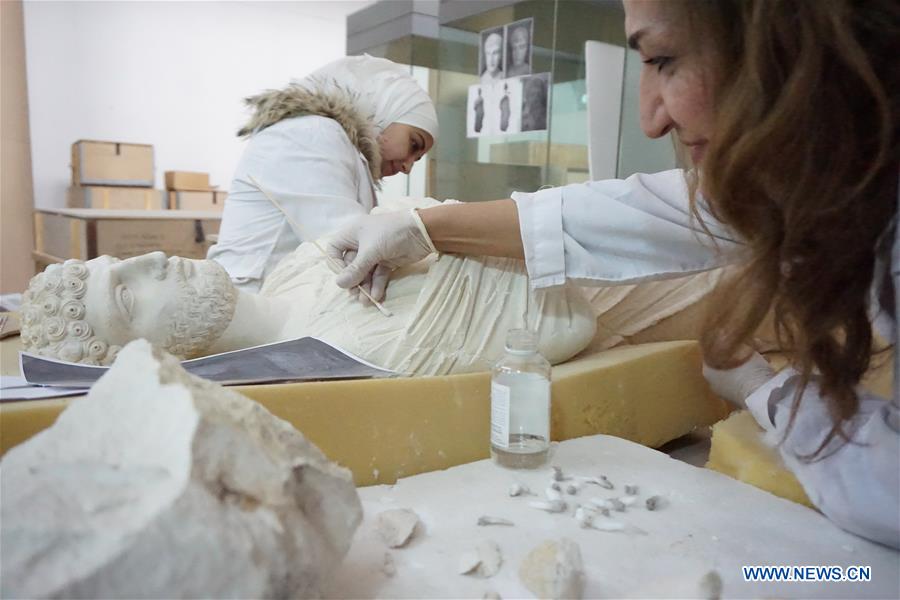Photo taken on Dec. 5, 2018 shows a team of local experts restoring damaged or fully-destroyed antiques, mostly from IS-looted city Palmyra, at the National Museum of Damascus in Damascus, Syria. The IS group had stormed Palmyra twice during the more than seven-year-long war, destroying precious archeological sites, such as temples and tombs, and shattering sculptures into pieces in the ancient oasis city, which is registered by the UNESCO as a world heritage. After the war was over in Palmyra, the authorities brought in hundreds of damaged and fully-destroyed artifacts to the National Museum of Damascus to fix them, a process that is expected to take between five and eight years depending on the size of destruction and the availability of the materials used in the restoration process. (Xinhua/Wang Jian)
by Hummam Sheikh Ali
DAMASCUS, Dec. 7 (Xinhua) -- Heba Jouma, a conservator-restorer from the ancient city of Palmyra in Syria, works to bring back ancient features to the sculptures damaged by the Islamic State (IS) group.
Jouma was born in Palmyra, where most of Syria's precious historical treasures are located. She grew up and became a conservator-restorer in the museum of her city, which is called the pearl of the Syrian desert.
She never imagined that one day she would work to piece up the 2,000-year-old sculptures of her ancestors, but the war always surprises people and shifts their lives in an unexpected way.
The IS group had stormed Palmyra twice during the more than seven-year-long war, destroying precious archeological sites, such as temples and tombs, and shattering sculptures into pieces in the ancient oasis city, which is registered by the UNESCO as a world heritage.
After the war was over in Palmyra, the authorities brought in hundreds of damaged and fully destroyed artifacts to the National Museum of Damascus for fixing them, a process that is expected to take between five and eight years depending on the size of destruction and the availability of the materials used in the restoration process.
Jouma, along with seven other restorers, started working to fix the pieces over the past few months. For her, the job has something special, as she had lived with these artifacts before and developed a special relationship with them as if they were her family members.
"Generally, I used to take care of these pieces as we used to perform a periodic check on them for any possible damage. They were in good health, but now I see them in a state of destruction," she told Xinhua.
"I feel that these artifacts have been a victim of a crime or homicide that's how I see it. Now, we are trying to bring them back to life," she said.
As in any family emergency situation, Jouma said she takes good care of them now that they are unwell. She even asks her fellow restorers to treat the artifacts with extreme gentleness.
She has even named many sculptures, saying it is easier to talk with them. Jouma said she speaks to them while fixing them, such as saying "sorry for what happened to you" or "come on getting well I am trying my best here."
"I feel that some of them are my children and some like parents. I feel that they are a part of me I cannot express enough the sadness that I feel for what had befallen them," she said.
Sure, many of the sculptures at the restoration section in Damascus museum are busts of old characters in Palmyra and those busts had largely been placed as headstones over tombs of the ancient people in Palmyra.
Much of the damage has been made on the busts' faces, which were used, in the old times, to make statues for the soul to return to the bodies of the deceased.
Jouma and her colleagues said they are fixing the faces so that the spirits of the dead could return in peace one day.
The woman said she will keep working and restoring these artifacts so that they could return home together, to Palmyra.
"Anyone should be able to return home. These artifacts must return and the Palmyra museum should return as well," she stressed.
Khalil al-Hariri, director of the Palmyra Museum, succeeded to secure the escape of a number of artifacts from Palmyra museum just as the IS were inching closer to the city.
"During our escape from the city, bullets rained down on us from all directions, and I was injured in the hand. We escaped because it was better to salvage the artifacts and deliver them to safety rather than to lose our lives and the artifacts," he told Xinhua.
During the Syrian war, the Syrian authorities shut down lots of museums around the country and safely stored away over 300,000 pieces, but some sites such as in Palmyra were still destroyed by the IS, damaged or looted.
Antiquities officials said more than 9,000 artifacts were restored and reclaimed during the war, noting that thousands more were smuggled out of the country.
Now that the situation has been largely improved in the country in favor of the Syrian government, the authorities have recently re-opened a portion of the Damascus National Museum since 2012.
The opening of the museum comes in tandem with the restoration process of the damaged artifacts, under the supervision of the Syrian experts.
Mahmoud Hammoud, head of the Directorate-General for Antiquities and Museums, said that all of the damaged pieces currently under restoration are from Palmyra.
Despite the efforts to salvage the historic treasurers, the official said that a catastrophe has befallen the Syrian cultural heritage.
"All of the sites that went out of the government control were subject to the illegal excavations and destruction," he lamented.
The opening of the museum and the restoration process started by local experts delivers a message that the rich cultural heritage of Syria is still there despite the war and the destruction of some of the most precious historical treasures, he added.


















